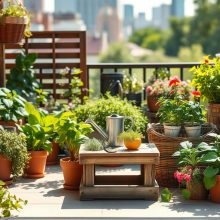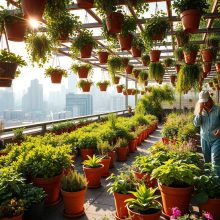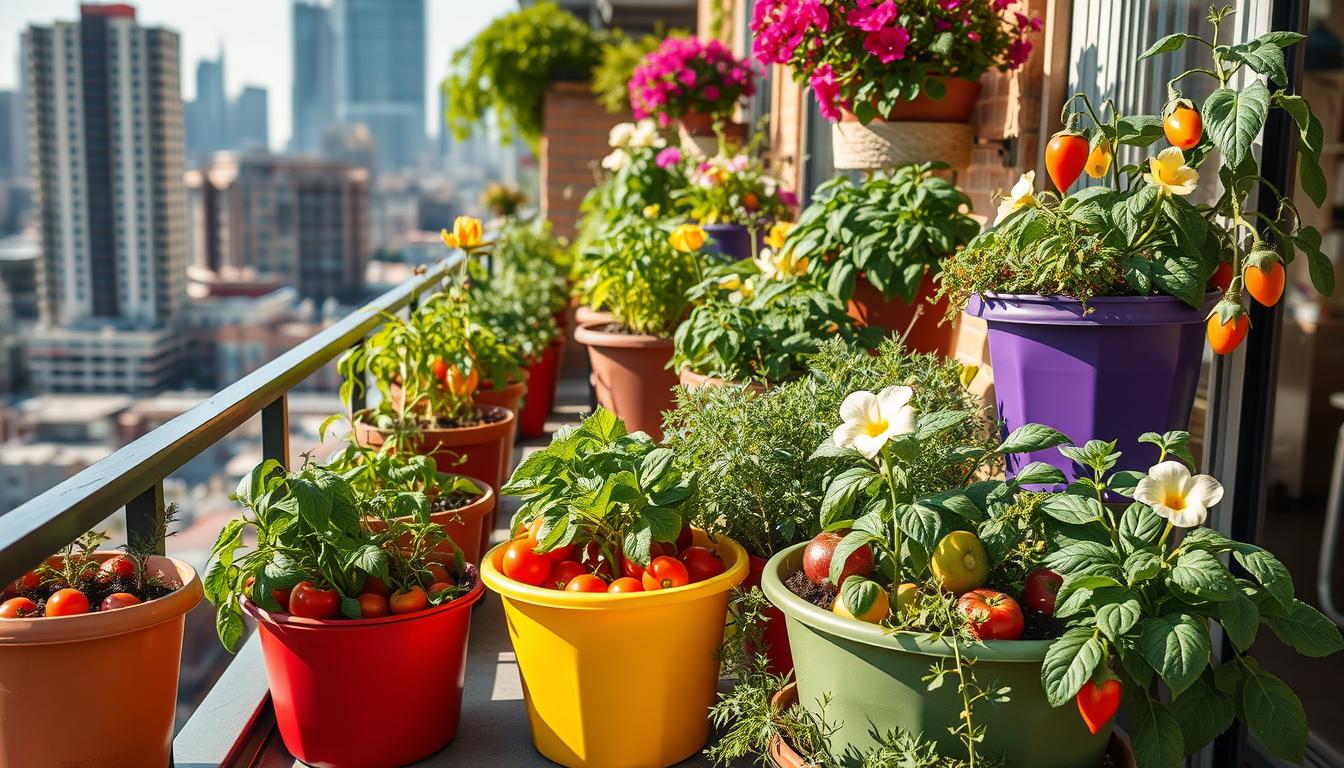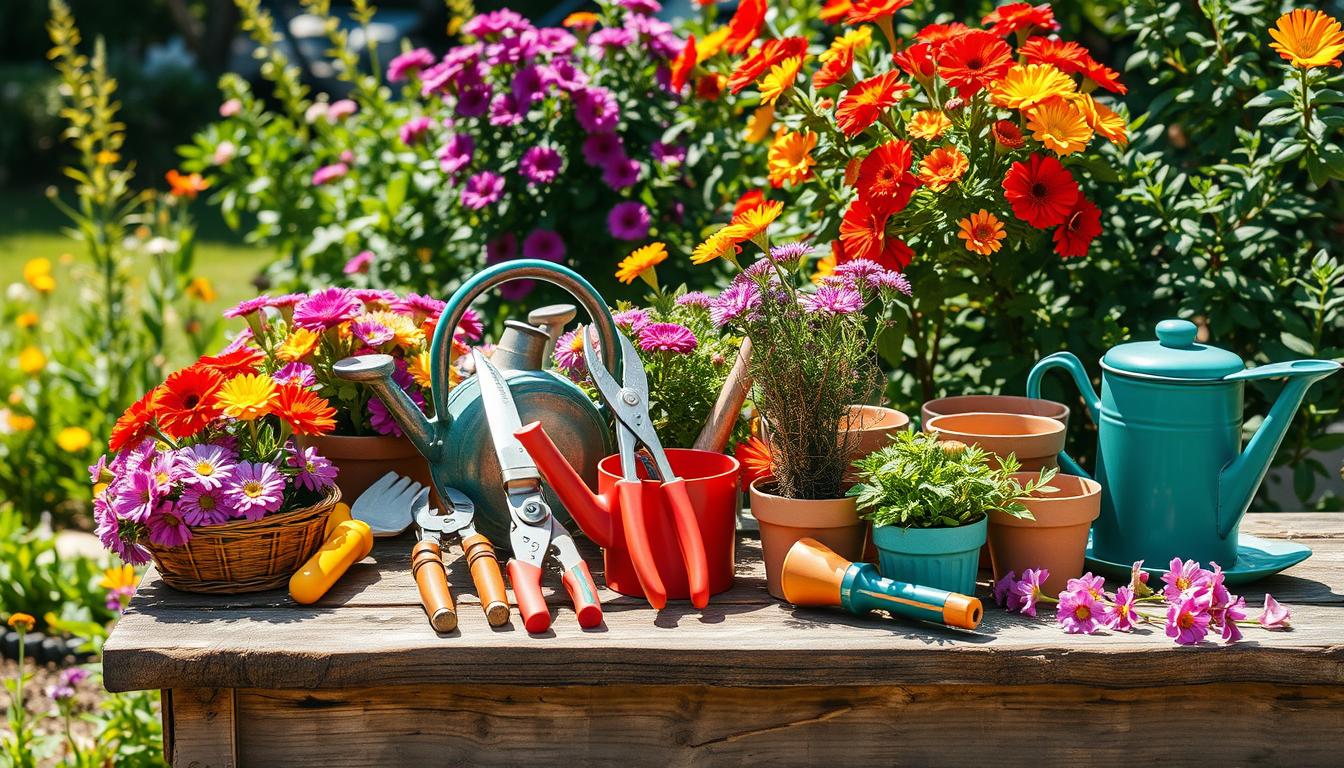A Complete Guide to Raised Bed Gardening for Beginners
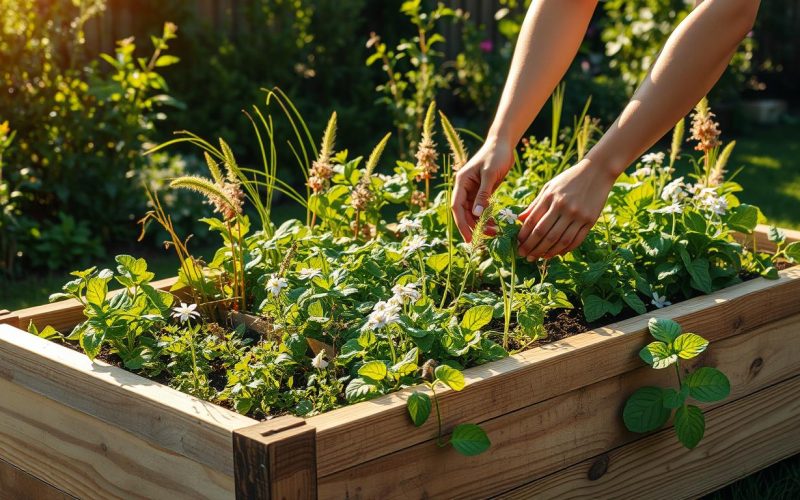
Vegetable gardening has changed a lot with raised bed gardening. It gives home gardeners a new way to grow fresh food. This method helps gardeners get the most out of their space and avoid common gardening problems.
Raised bed gardening is a smart way to grow plants. It makes your garden better in many ways. Gardeners in the U.S. say it makes the soil better, helps with water, and keeps plants healthy.
Whether you’re new or have been gardening for a while, raised bed gardening is great. It lets you control the soil, fight pests better, and grow more food in less space.
Key Takeaways
- Raised bed gardening creates optimal growing conditions
- Improves soil quality and drainage
- Enables better pest management
- Suitable for small and large garden spaces
- Increases vegetable gardening success rates
- Provides ergonomic gardening experience
- Adaptable to various climate conditions
What is Raised Bed Gardening?
Raised bed gardening has changed urban and container gardening. It lets gardeners grow plants in small spaces. This method creates elevated areas for growing, helping both new and seasoned gardeners.
At its heart, raised bed gardening grows plants in raised soil areas. These beds are made from wood, metal, or other strong materials. They give a clear space for plants to grow.
Understanding the Basics
The key features of raised bed gardening are:
- Controlled soil environment
- Improved drainage capabilities
- Enhanced plant root development
- Optimal for urban gardening spaces
Tracing the Origins
Raised bed gardening isn’t new. The Egyptians and Mayans used it to grow crops in tough terrains. Today, urban gardening has adopted these ideas for modern spaces.
It’s loved by those who garden in small areas. Raised beds work well on balconies or small backyards. They’re great for growing veggies, herbs, and flowers.
Benefits of Raised Bed Gardening
Raised bed gardening is great for both new and seasoned gardeners. It changes how we grow plants, making it perfect for city and suburban areas. By lifting your garden, you open up new ways to garden organically and grow plants efficiently.
Improved Soil Drainage
One big plus of raised beds is better soil drainage. Regular gardens often hold too much water and have poor soil. Raised beds fix this by:
- Letting water drain faster
- Keeping soil from getting compacted
- Helping roots grow better
Better Pest Control
Raised beds make small-space gardening easier. They act as natural barriers against pests. Gardeners can use:
- Physical barriers to keep pests out
- Easy ways to check on plant health
- Controlled organic gardening methods
Enhanced Accessibility
Raised beds are a game-changer for people with mobility issues. They make gardening easier by reducing bending and strain. They’re great for:
- Elderly gardeners
- People with physical limitations
- Urban gardeners with little space
Choosing the Right Location for Your Garden
Finding the perfect spot for your raised bed garden is key to its success. Good garden design is essential for a thriving small-space garden. The right location can greatly affect plant growth and garden health.
When designing your garden, several factors are important for the best location. Small-space gardening needs careful thought about the environment to get the most from your plants.
Sunlight Requirements
Most vegetables and herbs need lots of sunlight to grow well. Here are some tips for getting the right amount of sun:
- Aim for 6-8 hours of direct sunlight daily
- Track sun patterns across your yard throughout the day
- Observe potential obstructions that might block sunlight
Proximity to Water Sources
Good irrigation is vital in small-space gardening. Pick a spot close to water sources to make gardening easier.
- Position beds near outdoor faucets or water lines
- Consider installing drip irrigation systems
- Ensure convenient water access reduces maintenance effort
Avoiding Unwanted Shade
Good garden design means avoiding too much shade. Check locations carefully to get the most sunlight and avoid shade from trees or buildings.
- Keep beds away from large trees with expansive root systems
- Avoid placing beds near buildings that cast long shadows
- Use temporary markers to track sun movement before final placement
Selecting Materials for Raised Beds
Choosing the right materials for your raised beds is key in container and organic gardening. The materials you pick affect the bed’s durability, cost, and success. Thinking about different options helps create a sustainable and productive garden.
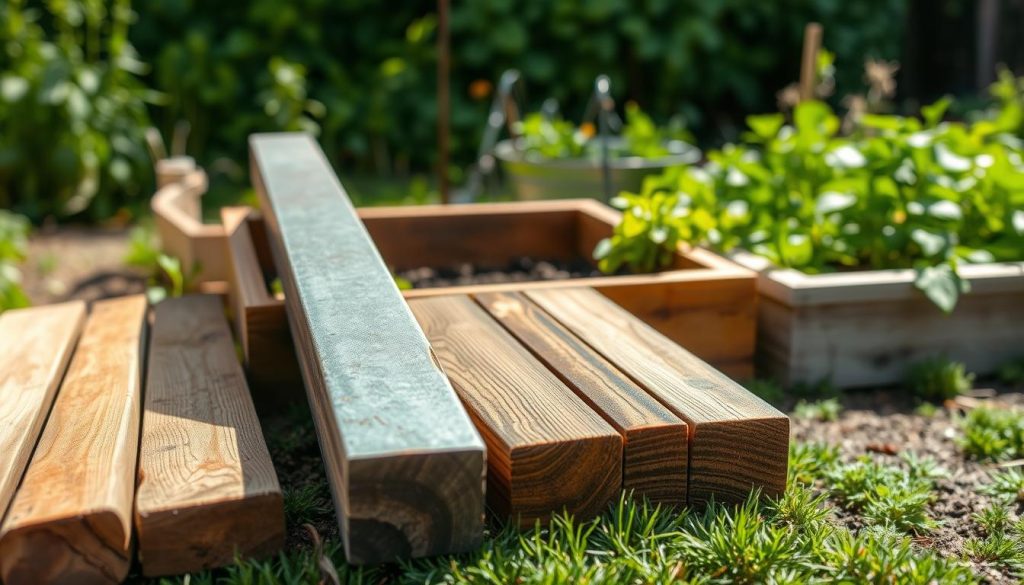
Wood Options: Cedar vs. Pine
When picking wood for raised beds, gardeners often choose between cedar and pine. Cedar is very durable and fights off rot and insects well. Pine is cheaper but needs extra treatment to last longer.
- Cedar: Naturally weather-resistant
- Pine: Budget-friendly option
- Both provide excellent structural support for container gardening
Alternative Materials: Metal and Composite
There are also metal and composite materials for raised beds. Galvanized metal beds last a long time and look modern. Composite materials are eco-friendly, made from recycled plastics and wood fibers.
- Metal beds: Durable and sleek design
- Composite materials: Eco-friendly option
- Resistant to decay and pest intrusion
Considerations for Sustainability
Sustainability is important when choosing materials for organic gardening. Go for materials that are good for the environment, like recycled composites or locally sourced wood. Think about the whole life of your raised bed materials to make your garden eco-friendly.
- Choose renewable resources
- Avoid chemically treated materials
- Select long-lasting options
Designing Your Raised Bed
Creating the perfect raised bed needs careful planning and a thoughtful garden design. Small-space gardening requires a strategic approach to make the most of both function and beauty. The right design can turn a simple garden area into a productive and stunning outdoor space.
When designing your raised bed, several key factors will guide your choices. Successful garden design starts with knowing your specific gardening needs and the space you have.
Optimal Dimensions and Height
The best raised bed sizes are usually 3-4 feet wide and 6-8 feet long. These sizes let you reach all sides without stepping into the growing area. Consider the height based on:
- 6-12 inches for most vegetable crops
- 12-18 inches for root vegetables
- 24 inches for gardeners with mobility challenges
Strategic Layout Planning
Small-space gardening needs smart layout choices. Gardeners can pick between single and multiple bed setups based on their needs:
- Single bed: Great for small spaces
- Multiple beds: Good for crop rotation and diverse planting
- Modular design: Offers flexible arrangement options
Aesthetic Design Elements
Beyond function, raised beds can also boost your garden’s look. Think about adding decorative touches like painted borders, integrated trellises, or materials that match your landscape’s design.
Soil Preparation for Raised Beds
Creating the perfect soil is key for a successful raised bed garden. Good soil preparation is the base for healthy plants and plenty of harvests. Organic gardening starts with making a soil that’s rich in nutrients and supports strong plant growth.
Understanding Soil Composition
Soil preparation needs a careful plan for the best growing space. The ideal raised bed soil mix is:
- 60% high-quality topsoil
- 30% compost
- 10% more organic matter
Soil Testing Essentials
Before planting, a detailed soil test is vital. It shows what your soil is like. Local agricultural offices offer cheap soil tests that tell you:
- Soil pH levels
- Nutrient deficiencies
- Mineral content
Adding Organic Amendments
Choosing the right soil amendments is crucial for organic gardening. You can boost soil quality with natural materials like:
- Aged compost
- Aged manure
- Worm castings
- Bone meal
- Kelp meal
These additions make the soil better, improve drainage, and give plants the nutrients they need. Mixing them well creates a balanced, fertile space for your garden.
Choosing Plants for Your Raised Bed
Starting a vegetable garden in a raised bed is exciting. It’s all about picking the right plants. Knowing which plants go well together and what they need is key. This makes your garden grow well and look great.
Cool vs. Warm Season Crops
Some veggies love cooler weather, while others need it warm. Cool season crops like lettuce and spinach grow best in 50-70°F temperatures. They do well in early spring or late summer.
On the other hand, warm season crops like tomatoes need it hotter. They thrive when it’s above 70°F. Plant them after the last frost.
- Cool Season Crops:
- Lettuce
- Kale
- Broccoli
- Peas
- Warm Season Crops:
- Tomatoes
- Peppers
- Eggplant
- Squash
Companion Planting Principles
Planting the right veggies together can make your garden better. Some plants help each other grow and keep pests away. For instance, basil near tomatoes can keep bugs off and make tomatoes taste better.
Succession Planting Strategies
Succession planting makes your raised bed work harder. It means planting new veggies as old ones finish. This way, you get a steady supply of fresh produce all season long.
- Plant quick-growing crops between slower-growing vegetables
- Replace harvested crops with new seedlings
- Rotate crop families to maintain soil health
Implementing Effective Watering Techniques
Raised bed gardening needs a smart watering plan. Keeping plants hydrated is key for their health and growth. Gardeners must know that raised beds dry out quicker than regular gardens.
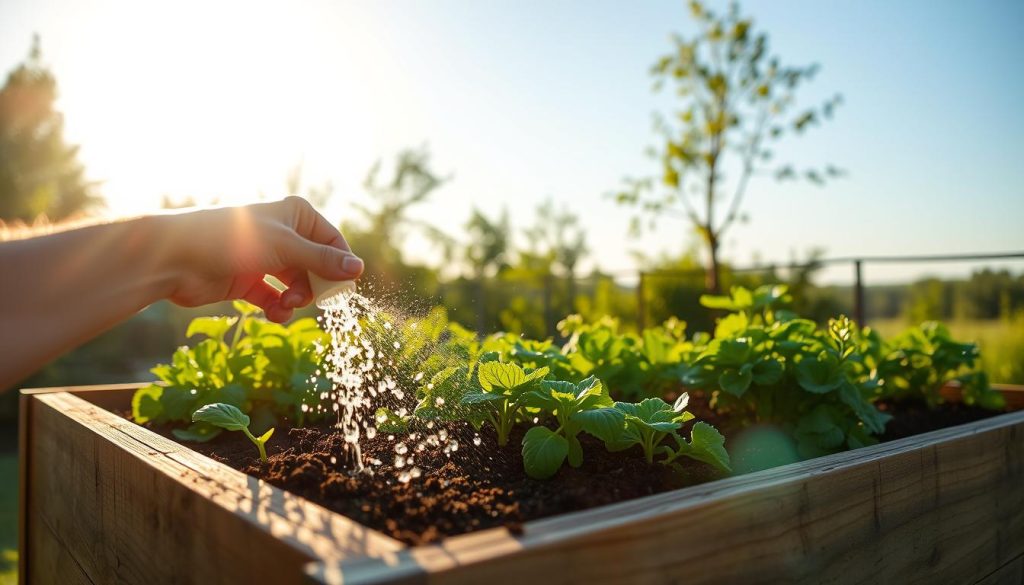
Organic gardening requires watching water closely. Raised beds drain well, but plants need more water to stay moist.
Drip Irrigation Systems
Drip irrigation is a smart way to keep plants watered. It sends water straight to the roots, saving water and preventing diseases.
- Reduces water consumption by up to 50%
- Provides targeted moisture
- Minimizes weed growth between plants
Hand-Watering Best Practices
If you water by hand, preparing the soil is important. Mulch and organic matter help keep water in and soil moist.
- Water early morning or late evening
- Aim water at the base of plants
- Check soil moisture before watering
Watering Schedules
Make a watering plan that fits your plants and weather. Most veggies need about 1 inch of water a week. But, this can change with temperature and plant type.
Keep an eye on your garden’s water needs. Watch how your plants do and adjust your watering to help them grow well in your raised bed garden.
Managing Weeds and Pests
Keeping a raised bed garden healthy means controlling pests and weeds. Organic gardening has great ways to do this without harsh chemicals. Learning natural methods helps protect your plants and keeps the garden balanced.
Raised beds make pest control easier. Their design and controlled space help manage weeds and bugs better than ground gardens.
Organic Weed Control Methods
- Apply thick organic mulch layers to suppress weed growth
- Use landscape fabric as a weed barrier
- Practice regular hand weeding
- Maintain consistent soil coverage
Integrated Pest Management Strategies
Integrated pest management aims for ecological balance. Knowing pest behaviors and using preventative methods helps avoid toxic solutions.
- Identify beneficial insects
- Monitor garden regularly
- Remove diseased plants promptly
- Create physical barriers
Companion Planting for Pest Control
Planting certain herbs and flowers can keep pests away. They protect your vegetables and add to the garden’s diversity. Marigolds, basil, and nasturtiums are great for this.
Seasonal Care and Maintenance
Keeping a raised bed garden healthy all year needs careful attention. Gardeners know each season has its own needs. They focus on crop rotation and soil care to keep their gardens lively.
Spring Garden Revival
Spring is when your garden starts fresh. First, clean out your raised beds from winter. Then, do a deep soil check. Important steps include:
- Testing soil pH and nutrient levels
- Adding fresh compost
- Checking for soil compaction
- Planning crop rotation strategies
Summer Garden Management
Summer means keeping a close eye on your garden. A good maintenance plan is key. It should cover water, pests, and soil health. Rotating crops helps keep soil rich and pests away.
- Water deeply and consistently
- Mulch to retain moisture
- Monitor plant health
- Remove weeds promptly
Fall Garden Closure
Winter prep is vital for your garden. Clean out old plants, add organic stuff, and plant cover crops. This keeps your soil ready for next year.
- Remove dead plant material
- Add organic compost
- Plant cover crops
- Protect soil from erosion
Harvesting from Your Raised Bed
Harvesting is the best part of gardening. After caring for your raised bed, knowing when and how to pick your veggies is key. This ensures your organic gardening efforts pay off.
Knowing When to Harvest
Timing is everything in gardening. Each crop has its own way of telling you it’s ready:
- Leafy greens are ready when they’re big but before they flower
- Tomatoes are ripe when they’re deep, bright colors
- Root veggies can be checked by gently pulling them
- Herbs should be picked before they start to flower
Best Harvesting Practices
Good harvesting practices help your plants keep producing. Always use clean, sharp tools to avoid harming your plants. For veggies like lettuce and kale, pick the outer leaves first. This lets the inner leaves keep growing.
Storing Your Garden Produce
Proper storage makes your homegrown veggies last longer:
- Wash veggies gently with cool water
- Dry them well before storing
- Use containers that let veggies breathe
- Keep different veggies at the right temperature
Learning these harvesting tips will keep your raised bed garden full of fresh, healthy food all season.
Troubleshooting Common Issues
Raised bed gardening can face many challenges. It’s important to know how to spot and fix these problems. This way, gardeners can keep their gardens healthy and productive.
Identifying Plant Diseases
Plant diseases can harm your raised bed garden. Look out for these signs:
- Unusual leaf discoloration
- Wilting or stunted growth
- White or gray powdery patches
- Soft, mushy plant tissue
Soil Problems and Solutions
Soil preparation is key to avoiding garden problems. Bad soil can hurt plant growth. Testing your soil regularly can catch issues early.
- Check soil pH levels annually
- Add organic compost to improve nutrient content
- Aerate soil to prevent compaction
- Rotate crops to maintain soil health
Pest Control Strategies
Controlling pests needs a mix of methods. Using natural ways to fight pests is better than harsh chemicals. Spot pests early and use natural ways to keep them away.
- Introduce beneficial insects
- Use companion planting
- Install physical barriers
- Maintain garden cleanliness
Resources for Continued Learning
Learning more about raised bed gardening is a journey that never ends. It’s all about growing your knowledge and connecting with others who love gardening. Whether you’re just starting out or have been gardening for years, there’s always more to learn.
There are many resources available to help you grow as a gardener. Books like “Rodale’s Ultimate Encyclopedia of Organic Gardening” and websites like Fine Gardening are full of useful information. The National Gardening Association also has articles, tutorials, and advice for gardening in the city.
Online platforms like Udemy and Skillshare have courses on gardening. Local offices often host workshops and webinars. Online forums like Reddit’s r/gardening and Facebook groups are great for sharing tips and solving problems.
Joining gardening communities can really help you learn and get support. Local gardens, community gardens, and clubs are great places to learn by doing. By using these resources, you can keep improving your gardening skills and enjoy the process.
